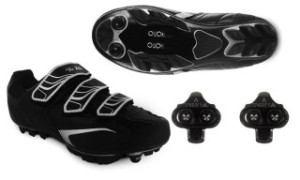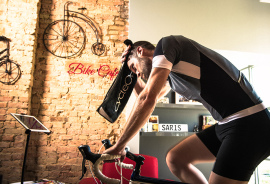A new rider recently reported to me that they are feeling constant numbness in their feet when attending indoor cycling classes. They had just purchased new cleats and had rejoined the class after a prolonged absence.
After making adjustments to the seat and handlebar positions, adjusting the clip positioning on the cleats and advising the rider to easy off on the resistance, the numbness gradually diminished. After about two weeks, the rider has reported that she is no longer feeling the numbness sensation.
If you have encountered a similar situation, ask your instructor to help you modify the bike’s setup as well as your indoor cycling shoes. It is imperative that you seek medical attention from you primary care provider if numbness persists or gets worse. If it does, cease all indoor cycling activity and contact your physician.
Here are five techniques you can employ to deal with numbness in your feet during indoor cycling class – please remember the note above if symptoms continue.
- Tight Shoes: if you just started wearing indoor cycling shoes, your feet will need a bit of an adjustment period. Assuming the shoes are the correct fit, any
 numbness sensation should disappear rather quickly. Wearing tight shoes causes inflammation between the joints that connect your toes to your feet, which results in decreased blood circulation that triggers foot numbness (when you ride, your foot will swell due to increased blood flow). Also, your socks may be too thick. If possible, wear thin socks or (and I have seen riders do this), wear no socks!
numbness sensation should disappear rather quickly. Wearing tight shoes causes inflammation between the joints that connect your toes to your feet, which results in decreased blood circulation that triggers foot numbness (when you ride, your foot will swell due to increased blood flow). Also, your socks may be too thick. If possible, wear thin socks or (and I have seen riders do this), wear no socks! - Incorrectly Positioned Clips: In addition to the issues related to incorrect fit (shoes too small, bike seat too high), the clips (SPD or LOOK) may be positioned incorrectly. For new shoes, if Velcro straps or closures are used, try to loosen them a bit so that your foot can easily slide in and out, but not too loosely so that you do not compromise your balance while riding. The cleat position should be where the ball of the foot lines up with the pedal spindle. Ask your instructor to adjust the clip positioning (most of us carry the typical Allen wrench). Remember if it takes you several attempts to clip in or if you struggle to clip out, the clips are incorrectly positioned.
- Ease Off: Riding with excessive resistance, mashing the pedals or not
 completing a full circle can contribute to incorrect posture, which may lead to discomfort in your joints and possibly numbness in the feet. Push and pull on the pedals, but do not pull up until you have reached the 6 o’clock position – a.k.a kick back with your heels. Build your endurance gradually, listen to your body and easy off on the resistance if numbness persists. Riding “hard” may build callouses on the bottom of your feet; when you pedal and push down on the pedals, they can cause foot pain and even some numbness.
completing a full circle can contribute to incorrect posture, which may lead to discomfort in your joints and possibly numbness in the feet. Push and pull on the pedals, but do not pull up until you have reached the 6 o’clock position – a.k.a kick back with your heels. Build your endurance gradually, listen to your body and easy off on the resistance if numbness persists. Riding “hard” may build callouses on the bottom of your feet; when you pedal and push down on the pedals, they can cause foot pain and even some numbness. - Rest: When you notice the onset of numbness, reduce your resistance to that of
 being on a flat road, slow down, wiggle your toes and rest. Pedal at low speeds. Gradually increase speed and observe at which resistance number the numbness returns. Your body may not be ready yet
being on a flat road, slow down, wiggle your toes and rest. Pedal at low speeds. Gradually increase speed and observe at which resistance number the numbness returns. Your body may not be ready yet - See Your Doctor: Of course, if numbness does not subside and it is noticeable during walking or normal daily activities, seek advice from your physician or podiatrist.
As indoor cycling instructors, we can help you modify the bike’s setup, adjust your
cleats or clips and advice you on proper ride posture and profile selection. However, there is no substitute to contacting your physician if numbness symptoms persist or worsen.
https://twitter.com/CycleWithTom
https://njcyclestudios.wordpress.com/author/cyclewithtom/




